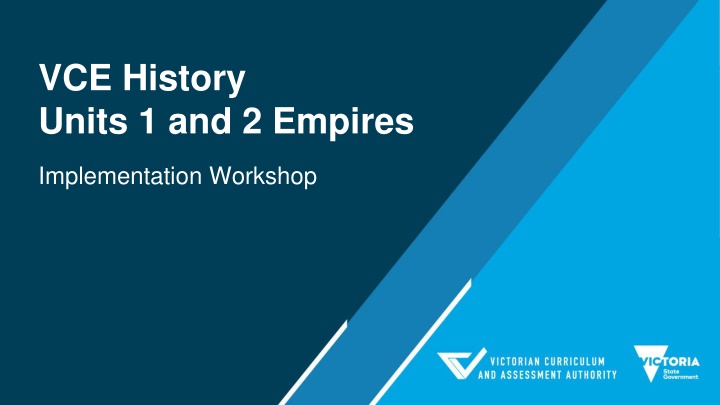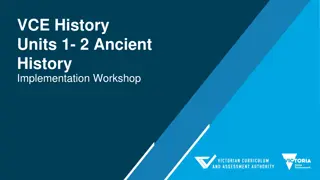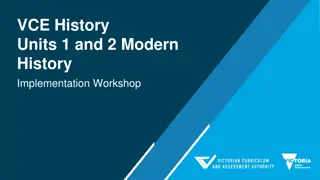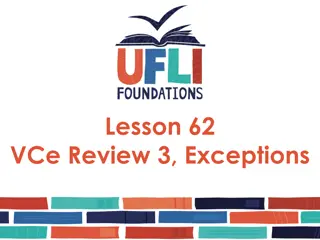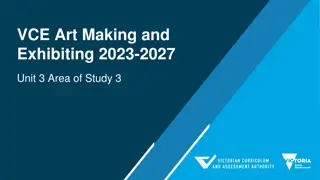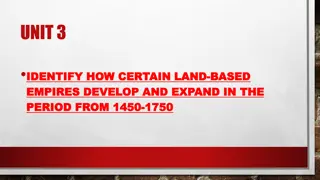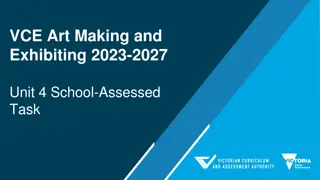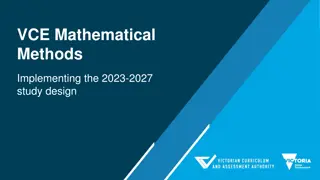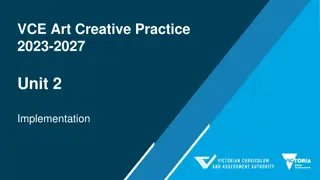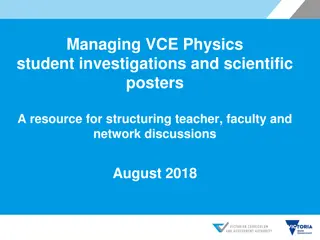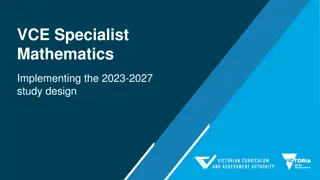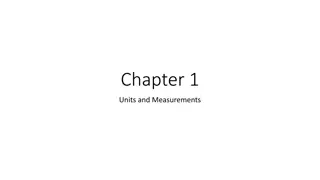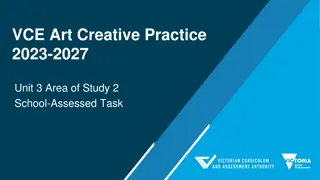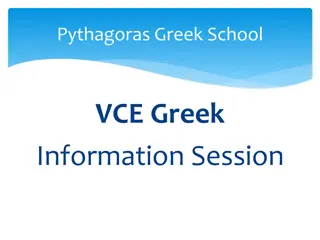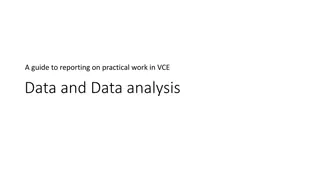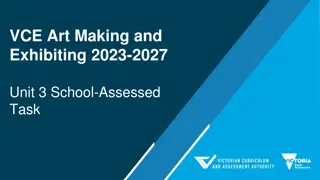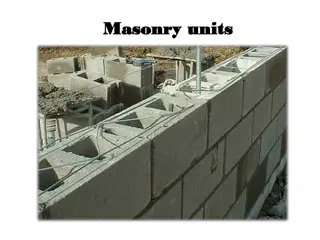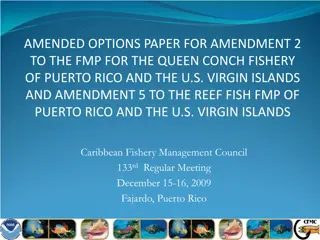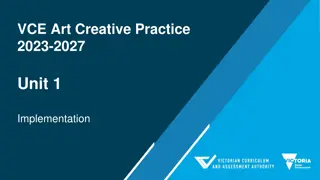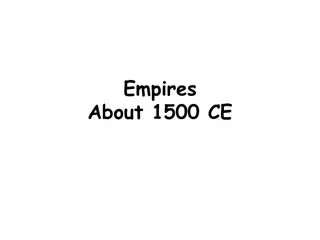Empires Implementation Workshop: VCE History Units 1 and 2
Explore Units 1 and 2 of VCE History focusing on empires, their rise, challenges, and consequences. Get insights on teaching ideas, areas of study, and the selection of empires for study. Acknowledge the traditional custodians of the land and delve into changes in outcomes and skills refinement.
Download Presentation

Please find below an Image/Link to download the presentation.
The content on the website is provided AS IS for your information and personal use only. It may not be sold, licensed, or shared on other websites without obtaining consent from the author.If you encounter any issues during the download, it is possible that the publisher has removed the file from their server.
You are allowed to download the files provided on this website for personal or commercial use, subject to the condition that they are used lawfully. All files are the property of their respective owners.
The content on the website is provided AS IS for your information and personal use only. It may not be sold, licensed, or shared on other websites without obtaining consent from the author.
E N D
Presentation Transcript
VCE History Units 1 and 2 Empires Implementation Workshop
Acknowledgment of Country Today I acknowledge the Wurundjeri people of the Kulin Nation as the traditional custodians of the unceded land in which I am working on today. I would also like to acknowledge the traditional custodians of the many lands across Victoria on which each of you are living, learning and working. I would like to pay my respects to elders past and present and extend that respect to any Aboriginal or Torres Strait Islander people who are joining us in this session.
Outline At a glance Features of Units 1 and 2 Empires Overview of the areas of study Teaching ideas Questions
At a glance Units 1 and 2 Area of Study 1 Area of Study 2 The rise of empires Encounters, challenge and change
Units 1 and 2 Empires Area of Study One and Area of Study Two Changes Major Review Reorganisation and clarification of the: - Outcome major refinement of the outcomes - Focus on the features, rise and expansion of empires - Focus on challenges, changes and consequences of imperial expansion - Key Knowledge refined and clarified with less specificity to apply to a range of empires - Key skills refinement to align with other Unit 1 and 2 Histories.
Changes Unit 2 outcomes are a repeat of Unit 1 Schools may offer Unit 1 and 2, one empire for Unit 1 and one empire for Unit 2 or Unit 1 only, one empire* or Unit 2 only, one empire* * Schools may select a Unit 1 or a Unit 2 from Units 1 and 2 Modern History or Units 1 and 2 Ancient History to have a Units 1 and 2 sequence.
Features What should influence the selection of empire for Unit 1 and/or Unit 2 Select empire(s) from the list. Ottoman Empire (1299 1699) Mughal Empire (1526 1758) Venetian Empire (1300 1797) Russian Empire (1552 1894) Ming Dynasty (1368 1644) Dutch Empire (1543 1795) Portuguese Empire (1415 1822) British Empire (1583 1788) Spanish Empire (1492 1713) French Empire (1605 1774) Qing Dynasty (1644 1911)
Big Planning Ideas Empires that intersect with one another for example the Venetians and the Ottomans or the Spanish and the British Empires that rise and fall The Ming and the Qing, the Mughal and the British Empires that establish settler colonies in contrast mercantile colonies The British and the Dutch Empires that build a deep content knowledge of Unit 3 and 4 Studies British, Russian, Qing and French
Units 1 and 2 Empires Units 1 and 2 Empires The rise of empires Student should be able to explain the significant features of an empire and analyse its rise and expansion. What were the foundations and features of the empire? What were the significant events and motivating forces that led to the rise of the empire? How did individuals, ideas and technologies contribute to the rise and expansion of the empire? How did the empire use and express its wealth and power? Area of Study One Outcome 1 Inquiry Questions
Units 1 and 2 Empires Area of Study One The rise of empires Key knowledge the physical environment and how it contributed to the development of the empire, the causes of the rise, expansion and consolidation of the empire, the social structure, demographics and identity of the empire, the economic features and conditions that contributed to the expansion of the empire, significant individuals who influenced, contributed to and/or undermined the empire, how political power was organised and expressed by the empire, the ideas that influenced change and/or disrupted traditional beliefs and institutions, the technological and scientific innovations that enabled expansion of the empire, cultural expressions that reinforced imperial power and expansion,
Units 1 and 2 Empires The rise of empires Area of Study One Relationship between Key knowledge and Skills ask and use a range of historical questions to explore the features of an empire analyse sources for use as evidence identify the perspectives of people in an empire and how they changed over time identify different historical interpretations about the features of an empire and reasons for its rise and expansion analyse the causes and consequences of the rise and expansion of an empire explain how the features of an empire changed and/or stayed the same evaluate the significance of events, ideas, individuals and movements construct arguments about the rise and expansion of an empire using sources as evidence.
Teaching and Learning Ideas analyse sources for use as evidence + the physical environment and how it contributed to the development of the empire The Venetian Empire Source based task: How did the geography of the Venetian Empire assist in its development? Provide students with a selection of contemporary works of art, City Lauds, Maps etc. scaffold their responses with a series of historical questions.
Sources you may like to use View of Venice by Jacopo de Barbari, 1500 The Lion of St Mark by Vittore Carpaccio, 1516 Praise of the City of Venice by Marin Sanudo, 1493
Teaching and Learning Ideas construct arguments about the rise and expansion of an empire using sources as evidence + how political power was organised and expressed by the empire, The Ming Empire Lotus Diagram: How did the political organisation of the Ming Empire facilitate its success? After examining the structures of the Civil Service, ask students to outline the attributes and impacts of the political system.
Teaching and Learning Ideas analyse the causes and consequences of the rise and expansion of an empire + significant individuals who influenced, contributed to and/or undermined the empire, The Mughal Empire Class inquiry: Mughal Emperor Akbar Ask students to map the achievements of Akbar including his political, social and economic reforms. Ask students to rank them in terms of significance.
Emperor Akbar How did Emperor Akbar contribute to the growth of the Mughal Empire? Rank Akbar s achievements from most to least significant using Partington s Criteria Creation of a new ruling elite Implemented modern administration Increased trade with Europe Establishment of a new religion
Partingtons Criteria for Historical Significance Partington, G. (1980) The idea of an historical education, Slough, NFER: 112-116. Importance-to the people in the past Profundity- how deeply people's lives have been affected Quantity- how many lives have been affected Durability- for how long have people's lives been affected Relevance- in terms of the increased understanding of present life
Units 1 and 2 Empires Units 1 and 2 Empires Encounters, challenge and change Area of Study Two Outcome 2 Student should be able to analyse the challenges and changes faced by the empire and evaluate the consequences of its imperial encounters in new territories and colonies, and on Indigenous peoples. How did the empire manage and consolidate its power and influence? How did daily life change through exchanges between empire and its colonies? What were the consequences of encounters between empire and indigenous peoples? To what extent did the empire decline and/or collapse? What were the significant legacies of the empire? Inquiry Questions
Units 1 and 2 Empires Encounters, challenge and change Area of Study Two Key knowledge the challenges of consolidating and expanding the power of the empire, the political, legal, social and economic structures and management of new territories, the competing motivations of individuals and groups in establishing and exploiting colonies, the economic exchanges between the empire and its new territories and colonies, differing perspectives and experiences of people in the empire, the rise of colonial identities and cultures and their contribution to imperial identity the intended and unintended consequences of interactions between colonisers, subjects and Indigenous peoples, the consequences of colonisation on the environment and society, the extent to which the power and authority of the empire changed or remained the same, the social, political, economic and cultural legacies and heritages of the empire,
Units 1 and 2 Empires Encounters, challenge and change ask and use a range of historical questions to explore challenges and changes to an empire analyse sources for use as evidence identify the perspectives of people in the empire and how perspectives changed over time identify different historical interpretations about the changes and challenges to an empire explain the consequences of challenges and changes to an empire explain how an empire changed and/or stayed the same evaluate the significance of events, ideas, individuals and movements construct arguments about the challenges and changes of an empire using sources as evidence. Area of Study Two Relationship between Key knowledge and Skills
Teaching and Learning Ideas identify different historical interpretations about the changes and challenges to an empire + the extent to which the power and authority of the empire changed or remained the same, The Ottoman Empire Source Task: The Decline of the Ottoman Empire Present students with a selection of primary and secondary sources that outline the internal and external problems that plagued the Empire from 1566. Use these sources as a basis for an extended response.
Teaching and Learning Ideas explain the consequences of challenges and changes to an empire + the rise of colonial identities and cultures and their contribution to imperial identity The British Empire Cause and Consequence Web: The Great Awakening Undertake a guided inquiry into the development, key beliefs and impacts of the Great Awakening. Ask students to identify causes and consequences and record them in a visual representation.
Students can use a graphic organizer such as this one to synthesise cause and consequence
Assessment Ideas Suitable tasks for assessment in these units may be selected from the following: a historical inquiry an essay evaluation of historical sources short-answer questions extended responses a multimedia presentation.
Historical Inquiry + Multimedia Presentation: The Atlantic Slave Trade Step 1: Students engage in preliminary exploration of the Atlantic Slave Trade. Students then develop a relevant inquiry question. Step 2: Students undertake research on their set question. They can record their research findings in a table and bibliography. Step 3: Students create a one page fact sheet for their peers and a multimedia presentation which they will deliver to the class. Step 4: Students complete a self assessment and peer review of one or more presentations. Teacher gives feedback and mark.
